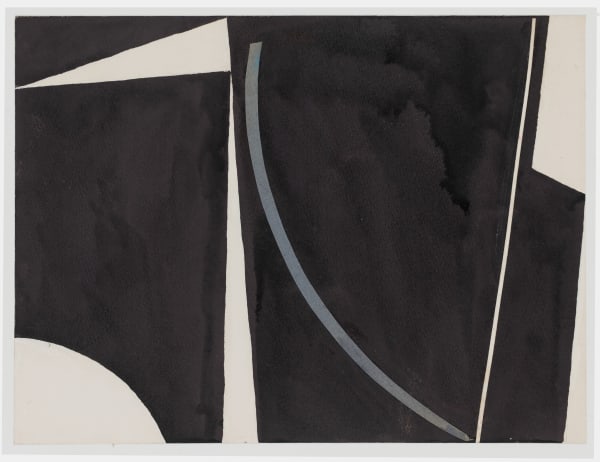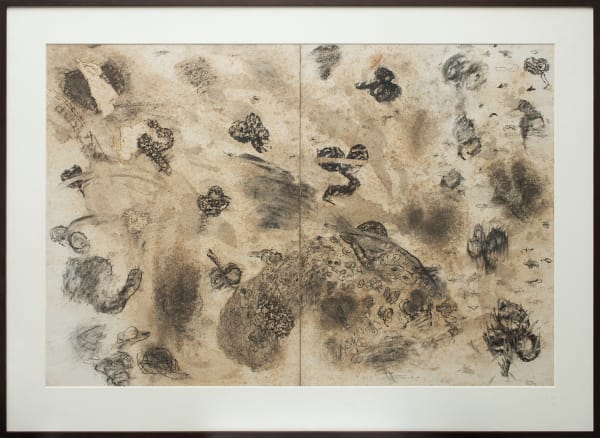I draw, therefore I think: Mehlli Gobhai & Vivan Sundaram | SOUTH SOUTH
We are delighted to participate in SOUTH SOUTH’s first Curatorial Project titled I draw, therefore I think curated by Jitish Kallat. This drawing project is prompted by Charles Darwin’s 1837 sketch ‘Tree of Life’ in which he scribbled down a framework for his speculations in his first “transmutation notebook”.
We present Mehlli Gobhai's Energy Diagrams from 1979, collages and drawings reduced to the taut interplay of line and curve, and Vivan Sundaram's Engine Oil and Charcoal drawings created as a reaction to the First Gulf War in 1991.
Energy Diagrams - Mehlli Gobhai
Mehlli Gobhai (1931–2018) pursued the objective of formal structure with a singular focus during the late 1970s and early 1980s. Renouncing his festive polychrome compositions of the mid-1970s, he adopted an austere palette of black, white and brown, occasionally relieved by saturated greens, terracotta and poster reds, ecru, and burgundy. In the spirit of an architect or surveyor, he used the plumb string, mapping his canvases by reference to the clarity of its line and the arc of its swing. Figures, vestigially present in his paintings of the mid-1970s, receded, leaving behind only their sharp, geometricized outlines. The imageless image, built from horizontal, vertical, diagonal and tilted lines, took centre stage. Fields of darkness contended with shards of illumination, as he moved towards an evocation of axial linearity. By 1979, Gobhai’s works assumed the form of energy diagrams, marked by scalar weights and vector forces. The quadrilaterals in these paintings are often shaped according to the golden section, a universal mathematical and geometrical ratio found in nature, architecture and music – in spiral venation, the pyramids, and the compositions of Claude Debussy and Erik Satie. Fittingly, the route to these paintings was laid through preparatory cut-outs, collages and drawings reduced to the taut interplay of line and curve. Experimentally, during this period, Gobhai used oils and acrylics as well as casein inks, dry pastels, aluminium powder, and conté. During this period, recognition came to him in the form of two major museum exhibitions in which he was invited to participate: ‘Marking Black’, curated by Madeleine Burnside (Bronx Museum of the Arts, New York, 1980) and ‘Hard Line: Drawing as a Primary Medium’ (Islip Art Museum, New York, 1984).
-Ranjit Hoskote & Nancy Adajania
Engine Oil and Charcoal: Works on Paper – Vivan Sundaram
After the outbreak of the First Gulf War in 1991, Vivan Sundaram made an important set of around forty drawings, Engine Oil and Charcoal: Works on Paper, as a reaction to the horrors of massive oil spills, oil fires of volcanic lava, and the army squadrons burnt alive. Occupying a place in between drawing, painting and installation, these compositions mark a pivotal moment in the artist’s practice at a crucial historical juncture. Here, for the first time Sundaram abandoned conventional painting; this series marks his transition to the installation, video, digital photomontage, and multi-media work that defines his practice from 1991 onwards. The slick of crude oil becomes his medium, as he begins staining the surfaces of his paper with it to convey the televised accounts of the war. By rubbing charcoal with his fingers he creates a smoked effect, suggesting the scenes of a war-devastated landscape and the tortured earth, and signaling an unhinged common future. As Sundaram introduces burned engine oil into his drawings, he moves us to see and smell a barreling smoke and contamination by energetically applying the heavy fuel onto the surface of his paper. These drawings have become fragile artifacts in their own right, growing more brittle, discolored, and faded over time, reflecting the reality of eco-historical change that itself of crucial concern in the works.
-Extracts from Mathur, Saloni. A Fragile Inheritance: Radical Stakes in Contemporary Indian Art. Duke University Press, Durham, 2019.
-
 Mehlli Gobhai, Untitled (Energy Diagrams), 1976
Mehlli Gobhai, Untitled (Energy Diagrams), 1976 -
 Mehlli Gobhai, Untitled (Energy Diagrams), 1975
Mehlli Gobhai, Untitled (Energy Diagrams), 1975 -
 Mehlli Gobhai, Untitled (Energy Diagrams), 1976
Mehlli Gobhai, Untitled (Energy Diagrams), 1976 -
 Mehlli Gobhai, Untitled (Energy Diagrams), c. 1975 - 1976
Mehlli Gobhai, Untitled (Energy Diagrams), c. 1975 - 1976 -
 Mehlli Gobhai, Untitled (Energy Diagrams), c. 1975 - 1976
Mehlli Gobhai, Untitled (Energy Diagrams), c. 1975 - 1976 -
 Mehlli Gobhai, Untitled (Energy Diagrams), c. 1975 - 1976
Mehlli Gobhai, Untitled (Energy Diagrams), c. 1975 - 1976 -
 Mehlli Gobhai, Untitled (Energy Diagrams), 1975 - 1976
Mehlli Gobhai, Untitled (Energy Diagrams), 1975 - 1976 -
 Mehlli Gobhai, Untitled (Energy Diagrams), c. 1975 - 1976
Mehlli Gobhai, Untitled (Energy Diagrams), c. 1975 - 1976 -
 Mehlli Gobhai, Untitled (Energy Diagrams), 1975 - 1976
Mehlli Gobhai, Untitled (Energy Diagrams), 1975 - 1976 -
 Vivan Sundaram, Flowers/Fragments, 1991
Vivan Sundaram, Flowers/Fragments, 1991 -
 Vivan Sundaram, Assault, 1991
Vivan Sundaram, Assault, 1991 -
 Vivan Sundaram, Fragments in a landscape, 1991
Vivan Sundaram, Fragments in a landscape, 1991














